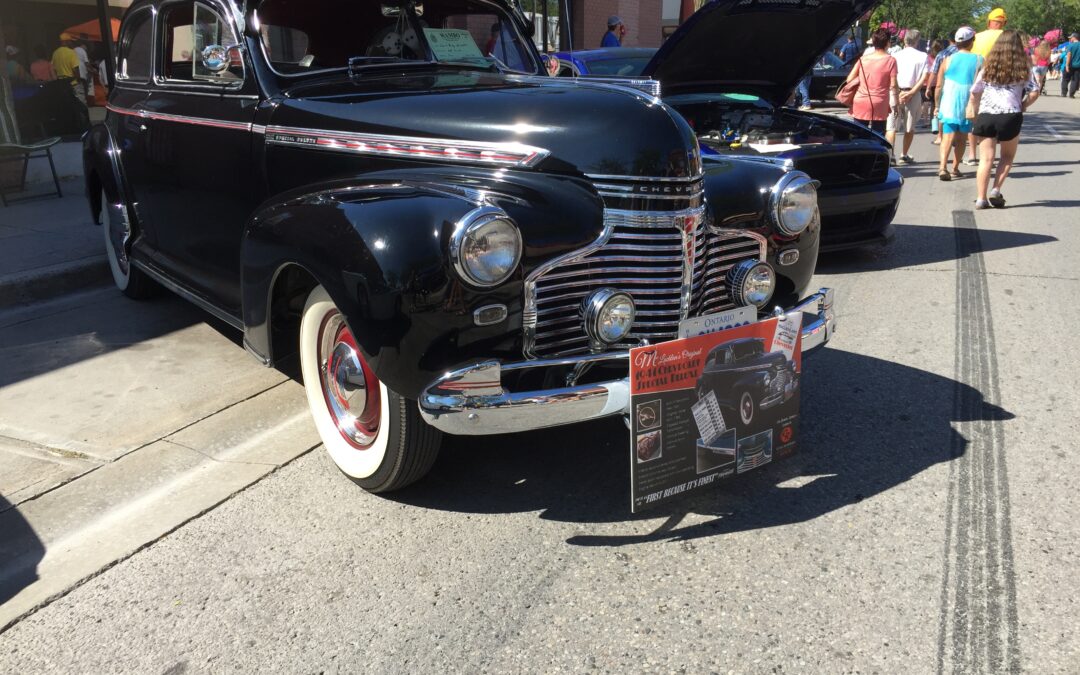Chevrolet sales broke the one-million mark for the first time during the 1941 model year, on the strength of beautiful looking automobiles, that were packing some of the latest technology, although still equipped with a six-cylinder engine.
Because of a curtailed production run for the 1942 model year, brought on by the United States’ declaration of war against Japan and Germany, the 1941 Chevrolets would remain the high-water mark for the General Motors division for almost a decade. It wouldn’t be until 1949 that Chevrolet sales would be stronger, and then only by 963 automobiles.
So what was it about the 1941 Chevrolets that was so special?
That’s difficult to define, since Chevrolet sales had been on an upward swing since the mid-1930s. The 1936 and 1937 model years were especially strong years, with Chevrolet selling 918,278 and 815,375 units respectively. Sales in 1938 took a big dip because of a downturn in the economy, but had regained strength by 1939 when the Big Bowtie sold 764,616 units.
But 1941 was a blowout yea – Chevrolet sold 1,008,978 units – compared to Ford’s 691,455 sales. Only a few years earlier, Ford had the best sales in the industry, selling 942,005 units for 1937. But Chevrolet had ruled the roost beginning in 1938, and had absolutely crushed the competition for 1941. Improvements had gradually been introduced to its models, and the styling had been progressively tweaked over the late 1930s.
Introduced in the fall of 1940, the new Chevrolets were an absolute sensation. They were bigger than their predecessors and for the third time in as many years, had come under the careful eye of GM styling chief Harley Earl, for yet another redesign. It was no mistake that the new Chevrolet resembled the prestigious Buicks. That was intended. Indeed, the car was handsome and impressive looking. Some called it the prettiest Chevrolet yet.
Available for 1941 from Chevrolet were the Special DeLuxe and the Master DeLuxe models, although a less expensive Special was available.
The new models had a longer wheelbase, at 116 inches, and their overall length had been stretched by three-and-a-half inches. The car’s weight was also heavier than the 1940 models.
The design featured a new grille. Moreover, the running boards were concealed and the headlamps blended in with the fenders. This was an industry-wide trend for the Detroit-based companies, but nonetheless, the impact on Chevrolet’s overall appearance was stunning. The car was streamlined and smooth, and looked thoroughly modern.
A bigger exterior translated into more interior space, and there were some refinements and touches of luxury, especially in the Special DeLuxe. Featured were cloth seats and a metal dashboard, and in the more expensive models, the dash was patterned with a simulated burl woodgrain. The radio was a mono vacuum unit with integrated speaker. The clock was integrated into the glove compartment. These were small touches perhaps, but they meant a lot to Chevrolet owners, who appreciated the fact they didn’t have to spend more for a Pontiac or an Oldsmobile, because they could equip their Chevrolet so favourably.
Chevrolet boasted that their new DeLuxe models provided three additional inches of hip room, which was also a selling point for showroom salesmen. The wider car was made possible by the near-elimination of the running boards. And with the transmission shifter moved to the steering column, most Detroit-based automobiles were offering enough room for three adults in the front seat. Those three extra inches were important.
Although still equipped with a straight-six engine, the new Chevrolets offered a redesigned cylinder head with a slightly higher compression ratio. That modification allowed for a horsepower improvement from 85 to 90. Such improvement was needed, because Ford had been offering a well-powered V8 for several years.
The new engine pistons for the 1941 Chevrolet were fitted, while the valves, rocker arms and water pump were entirely upgraded. The result was a smooth driving car that could achieve as much as 80 miles an hour without overdrive.
The Chevrolet transmission was a manual three-speed with vacuum-assisted shift. That meant that the column-mounted shifter could be moved between the gears by the slightest pressure on the lever.
Overdrive was a rare option.
General Motors provided its latest technology to its Chevrolet cars. The brakes were hydraulic with all-wheel drums. The car came with a brand-new suspension.
The Special Deluxe was the most expensive Chevrolet for 1941. Prices ranged from $769 to $995. The Master Deluxe price range, meanwhile, started at $712 and continued to $795. The most expensive Chevrolet was a Special DeLuxe station wagon. It had seating for eight people and sold for just under $1,000. That was a heck of a lot of money 80 years ago.
As already stated, Chevrolet sold a lot of cars for 1941. And perhaps surprising, most of them were the more expensive Special DeLuxe. A total of 602,113 units were sold, while 406,863 Master DeLuxe models were sold.
Chevrolet sales were subsequently low for 1942 because of the Americans’ decision to engage in the war on the Axis powers. Detroit car production was halted in February 1942 to allow for a transition to full-time war production. Total Chevrolet sales for that model year amounted to just 254,885 units.
The Special DeLuxe and Master DeLuxe would continue only briefly as Chevrolet models. The new post-war cars were introduced for the 1946 model year, and were essentially the same as offered for 1941 and 1942. But they had new names – the Stylemaster and Fleetmaster.
It wasn’t until 1949 when Chevrolet was able to offer a completely new car for its customers.
At a recent car show in Wallaceburg, a splendid example of a 1941 Chevrolet Special DeLuxe was on display. The two-door sedan is owned by John and Becky MacLachlan of Belle River. According to the owners, their Chevrolet was built at GM’s assembly plant at Tarrytown, NY and still has the original engine, although it was rebuilt in 2011. The MacLachlans had the interior reupholstered and painted, and the exterior chrome was resurfaced.
It’s a beautiful car and a vivid reminder of how handsome cars were in the early 1940s. Looking at the MacLachlans’ Chevrolet, it’s immediately understood why Chevrolet could sell over one million cars in that model year.

